Thoric Cederström (Washington, DC)

Mud and muck are flying in the US Presidential campaign. Both parties made a lot of noise at their political conventions about the state of the economy and the plight of working Americans. Since the 2008 financial crisis, many families have been struggling to keep their heads above water. Making ends meet—paying for housing, food, healthcare, and school—often leaves little for investing in the future and getting ahead. With livelihoods stagnated and little relief in sight, it is no wonder emotions are running high during this election period. The problem extends far beyond America. Outside the U.S., in the places where Creative is most active, conditions are much worse. The downturn in the global economy has adversely affected billions of people, thrusting many below the bare minimum requirements for a healthy life. Child malnutrition, once on the decline, is aggressively returning in many countries as food production stagnates and local food prices rise. The health of mothers is threatened by shrinking government budgets for maternal care and increasing costs of basic medicines. The need to “make ends meet” by millions of low-income families around the world increasingly forces them to pull children out of school in order to work or help at home while a parent forages for sustenance. As well, many sell off assets – livestock, equipment, property, etc.—to purchase food and other basic necessities. The trade-off is costly; future opportunities are sacrificed to immediate survival needs, and resilience—the ability to withstand and recover from future shocks—is severely compromised. As the global economy continues to change rapidly in very unpredictable ways, the ability of vulnerable households—those living on the edge—to adapt and survive will be especially challenging. Helping them is a priority and requires creative approaches to livelihood programming.
Recently, Creative Associates International had the opportunity to address these critical livelihood issues in innovative ways in the design of two livelihoods programs, in Haiti and Peru. In Haiti, the Creative Team partnered with various Haitian organizations to address the complex problems facing poverty-stricken, small-holder farmers in the northern corridor of that country. Centuries of deforestation and unsustainable farming practices, driven by poverty and a lack of opportunities, have left the hill slopes barren and denuded of vegetation. When hurricanes strike, any remaining topsoil is swept away downhill, wreaking havoc on communities in the valleys below. Creative and our partners have proposed an innovative solution of incentivized reforestation and watershed management based on intercropping food crops (corn and beans) with more valuable tree crops such as cacao (cocoa) and coffee. This combination helps families feed themselves and generate income. We proposed to help farmers sell carbon credits from their tree crops to the US voluntary market, thus generating another income stream and incentivizing farmers to plant more trees. As a result, more Haitian farmers will not only be able to “make ends meet”, but they will be able to invest in the future by being able to send their children to school, improving living conditions, and access quality health care. In Peru, we updated and expanded Creative’s highly successful Progreso experience from Colombia, funded by USAID, and adapted it to the particulars of illicit coca-production in jungle regions of Peru. Our basic premise is that farmers prefer to integrate into the greater community rather than stay isolated in the shadows of the illicit economy where they are exposed to violence, high risk, and poverty. By offering farmers memberships in cacao and coffee cooperatives, giving education scholarships to their children, and providing them with the means and markets for alternative licit crops, these brothers and sisters will break with the narco-controlled system and embrace alternative, more wholesome lifestyles with the promise of a better future. The proposed program also includes an interesting communications campaign that builds on past Creative experience while exploring new territory based on para-social contact theory. We aim to create a cast of social characters that will portray different aspects of Peruvian society so that viewers identify with the key messages through emotive connections with different actors. In the end, by creating the enabling environment and changing attitudes, former illicit coca producers will be able to engage in sustainable licit livelihoods and enjoy the full benefits of participating in the larger Peruvian society. These are lofty goals for sure, but obtainable with the right combination of conditions and effort. Finding that correct mix is the challenge all development programs face. As we look to the future, it is clear that vulnerable populations require both technical support and economic stimulus to improve their livelihoods. Most certainly the global marketplace will adjust itself to a new equilibrium, but one that could have devastating consequences for the poor in terms of prices for food, clothing, shelter, education, and other necessities. Coordinated policies and programs are required to create opportunities for investment, market growth, workforce development, and entrepreneurship that directly benefit the entire global community, not just the privileged parts. Creative can be at the forefront of this new thinking ,combining the best of the past with forward-thinking programs that see poor communities as part of the solution and not as the cause of the problem. “Blaming the victim” and “blaming the system” are archaic and misguided ways of framing the issue: we must embrace a holistic, inclusive approach that incorporates local innovations within a global solution. Only then can we move beyond just “making ends meet” and enjoy the prosperity that we all deserve.
Thoric Cederström, Director, Livelihoods Practice Area, Communities in Transition Division